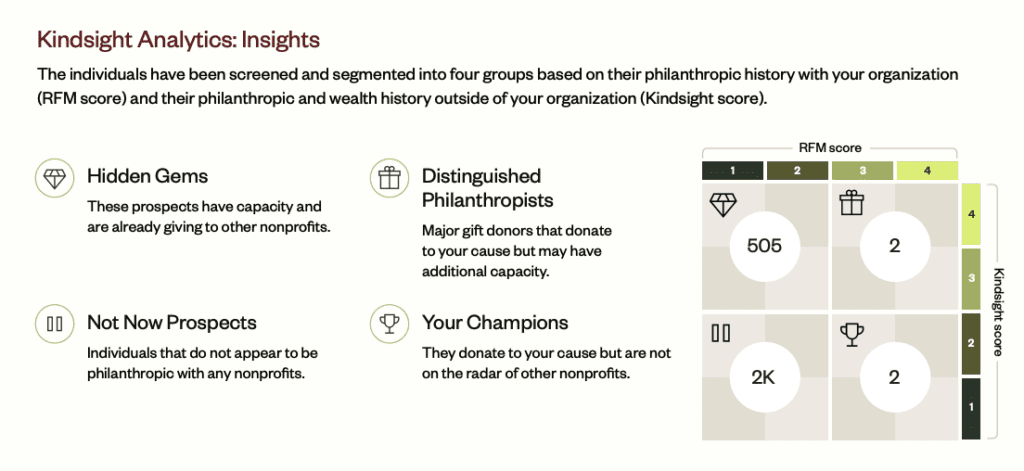
You’ve been staring at your list of prospects for a few days now. No stand-out priorities, no actions, no deadlines in sight. A prospect list can sometimes be really overwhelming. Whether that list comes from you or from someone on your fundraising team or board; it can be daunting. Your job as a researcher or fundraiser is to make sense of those lists. You bring a little perspective into that excel spreadsheet. But that all takes time, commitment, and the right tools to help you get the job done. Keep in mind, too, that the steps of taking a list and making it actionable are usually not linear. It is a cycle of doing research, creating profiles, verifying records, prioritizing your lists, and making recommendations.
Research: Always a Great Place to Start
You’ve probably heard by now that prospect research can help you to be prepared for all the steps in the donor cultivation cycle. It helps you go from a blank slate to an informed donor profile to a major gift ask. Research is a powerful tool which gives you insight into a prospect’s connection to your cause (affinity), their capacity (wealth), and their giving history (propensity). These three keys are crucial in identifying prospects that not only can give, but likely would give to your cause.
When you have these identifiers at your fingertips, you’re able to make an informed ask to the right person, at the right time. You are also empowered to prioritize your list and help your team to decide on timelines and next steps in your major gift fundraising efforts.
Quick tip: don’t forget to verify! The verification stage is really important to ensure your donor profiles are stacked with all the best information you can find, and that there are no pieces of information that could lead you astray in your gift ask.
Organizing Your List
There are a few ways of tackling your list. You could tackle each individual name one by one, search in your prospect research database to find records that fit that donor, create a profile on each, and in iWave you could generate their score in a matter of minutes. Or you could take your list and run it through a wealth screening. In Kindsight’s iWave, this will output your list of names with scores for each prospect automatically.
Either way, you’re now dealing with a list of names, profiles, and their scores. The iWave score measures the affinity, capacity, and propensity. The RFM score is a relationship score that visualizes how much a prospect loves your cause based on internal donation data. This is usually something that is tracked within your database. If you do a wealth screening with iWave, you’ll see both scores come back for each individual through our Insights analytics. Then you can take your analysis to the next level. Intrigued? Read on!
Analyzing Your List
iWave’s Insights feature places your prospects into four categories or segments. We combine your own RFM score and the iWave Score to give you a fresh, new look into your prospects. Now is your opportunity to verify and start segmenting your prospects based on their score and their level of priority.
If your prospect has received a high iWave score you may be thinking, ok – now what? So again, you’ve got a few possibilities here. If your prospect has received a 4, that’s amazing. That’s the highest they can get within iWave. It means (based on the preferences you have set) they have a strong capacity, affinity, and propensity to give. If you are looking at the score through the lens of your wealth screening insights (more on that in our fundraising survival guide), you will also see your prospects divided into 4 different categories.
Hidden Gems: These prospects are an exciting area of opportunity for your organization.
Distinguished Philanthropists: Great major gift donors that are interested in your organization.
Not Now Prospects: Individuals who aren’t philanthropic to you or any other nonprofit organization.
Your Champions: Prospects who both have an affinity to your organization and already donate to nonprofits.

The Priorities, Now
The last two categories are donors you can set aside for now. These are prospects that have low iWave scores (see image above). That doesn’t mean you dismiss them completely though! Your not-now prospects have low iWave and low RFM scores. This just means that they aren’t philanthropic to you or any other organization. Yet. There’s always hope for the future, right? Your champions are donors that give to you exclusively. So for them, they actually have a low iWave score because their philanthropy hasn’t extended to other organizations at this time. There is a fantastic opportunity here to put these people into a stewardship program of some kind, and to make sure you are thanking them on a regular basis for being a loyal donor to your cause. But in terms of your next major gift donors, they’re not the priority.
Now, here’s the exciting stuff. The first two categories are donors you can prioritize now. Your hidden gems especially, are prospects that aren’t necessarily giving to your organization yet, but they have a very strong capacity and propensity to give. That means, they just need to be asked! The second category worthy of your time is the distinguished philanthropists. They have a high iWave score and a high RFM score. These are donors that give regularly to you and to other organizations, but could have the capacity to give even more.
Don’t Be Afraid to Give Your Opinion
Now, you’ve got a list of some great potential donors. They’re complete with high scores and complete, verified profiles. Speaking of profiles, read more about building impactful donor profiles by checking out this blog post here.
Next up, you prioritize based on your organization’s goals. Maybe your gift officers are only asking for your top 10 prospects. Or maybe you’re making a priority list based on location, prospects that are likely to give now or later, etc. This is a key area where collaboration is key within your fundraising team. Make sure you are all working towards the same goal, with the same vision in mind.
Don’t be afraid to give your opinion here. You’re the master researcher. You’ve done all the work to create a profile. Now is your chance to take the insights you’ve learned about your prospects and put it into tangible, actionable pieces. This fantastic blog post from Jennifer Filla talks about adding those personal, invaluable touches to the information you’re giving to your team. She implores that we shouldn’t be afraid to voice our opinions and make recommendations:
“Sometimes the method of analysis is technically accurate and perfectly defective. It takes a curious mind and some sincere synthesis to process information in both micro and macro environments and make a recommendation.”
Do It Together
Setting goals and making recommendations is a difficult task. But especially in the fundraising world, we’re dealing with real people. You’re tasked with the job of finding people who could help push your nonprofit mission further. You’re also often tasked with finding people who are hard to find, researching for grants and foundations that are difficult to win, and ultimately advising on how much money to ask a person. None of these are easy! The key is to do this work together with your fundraising team. And never forget, you are doing amazing work. All the nitty-gritty, time-consuming, and difficult tasks you are faced with all make a difference in your organization, and in the world.
Be the first to read our resources.
The world is changing quickly—and our resources help you stay on top of it all. Sign up to get new insights, success stories, and more, sent right to your inbox.




